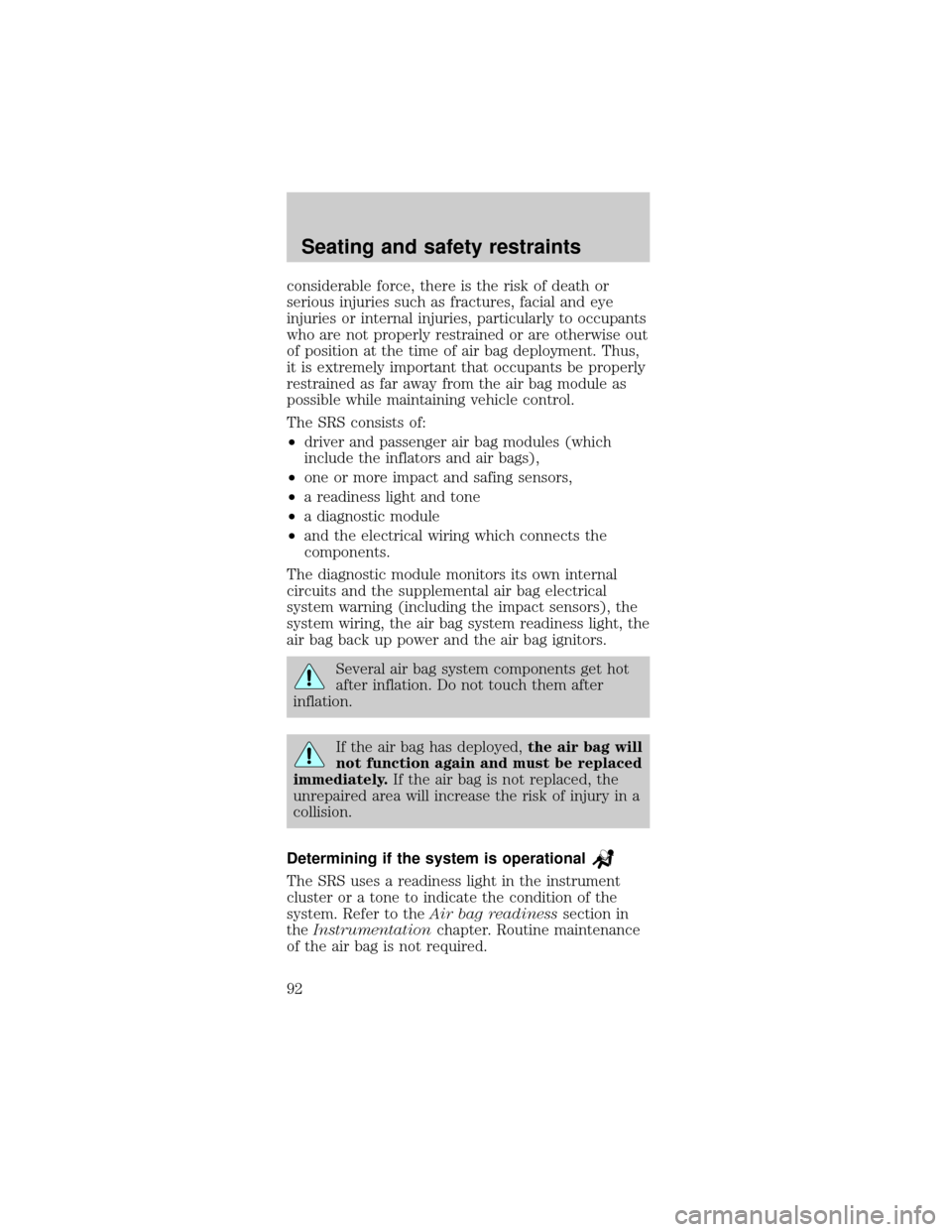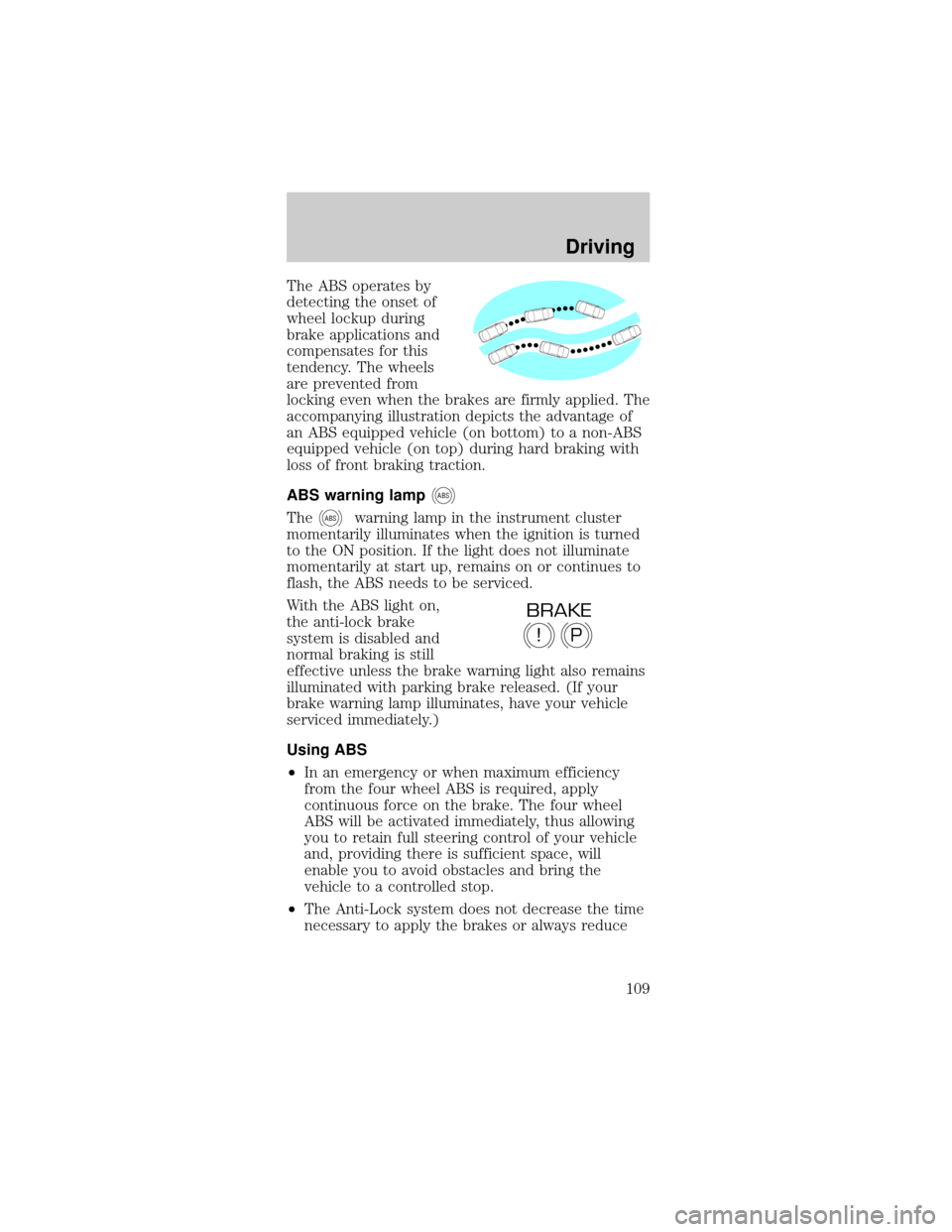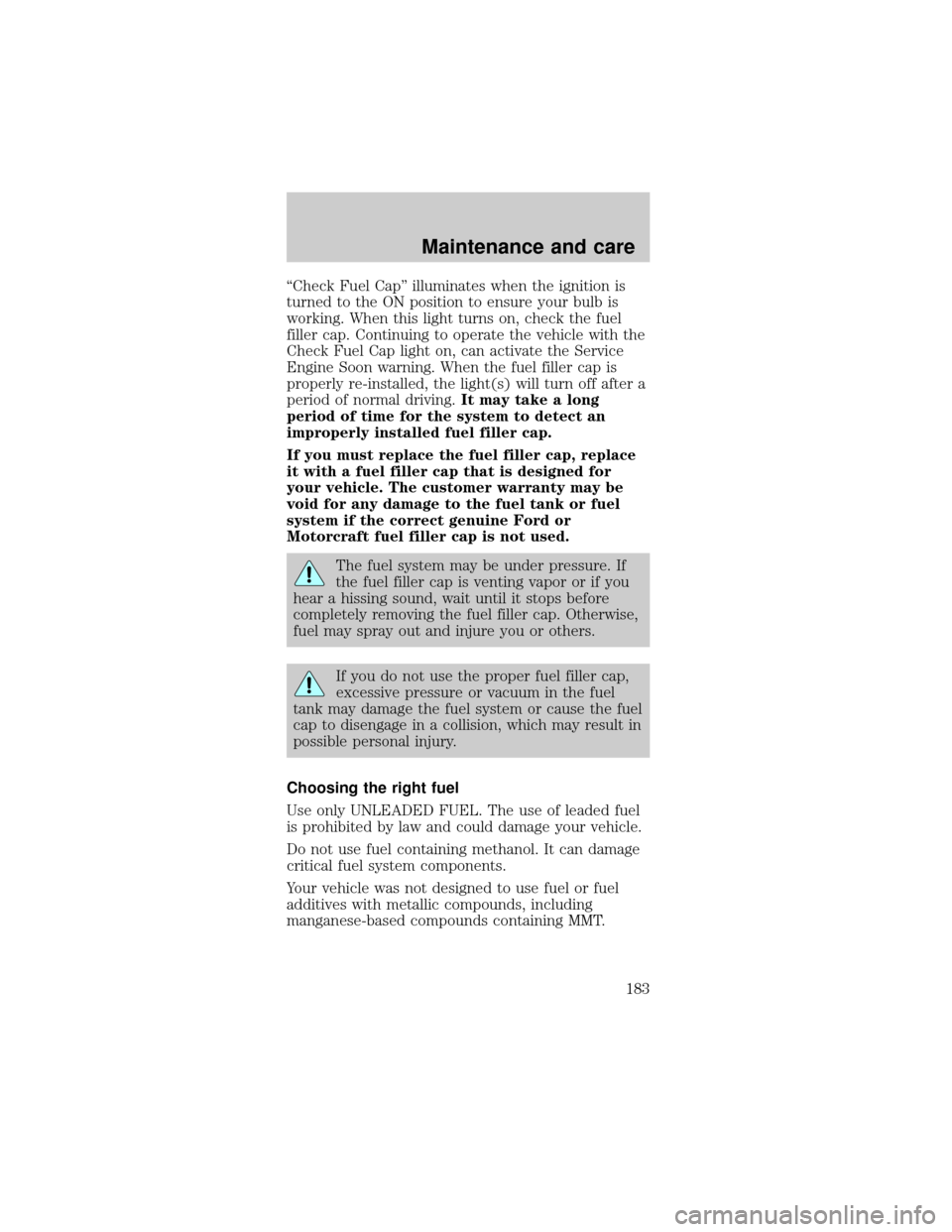2001 FORD MUSTANG warning light
[x] Cancel search: warning lightPage 92 of 240

considerable force, there is the risk of death or
serious injuries such as fractures, facial and eye
injuries or internal injuries, particularly to occupants
who are not properly restrained or are otherwise out
of position at the time of air bag deployment. Thus,
it is extremely important that occupants be properly
restrained as far away from the air bag module as
possible while maintaining vehicle control.
The SRS consists of:
²driver and passenger air bag modules (which
include the inflators and air bags),
²one or more impact and safing sensors,
²a readiness light and tone
²a diagnostic module
²and the electrical wiring which connects the
components.
The diagnostic module monitors its own internal
circuits and the supplemental air bag electrical
system warning (including the impact sensors), the
system wiring, the air bag system readiness light, the
air bag back up power and the air bag ignitors.
Several air bag system components get hot
after inflation. Do not touch them after
inflation.
If the air bag has deployed,the air bag will
not function again and must be replaced
immediately.If the air bag is not replaced, the
unrepaired area will increase the risk of injury in a
collision.
Determining if the system is operational
The SRS uses a readiness light in the instrument
cluster or a tone to indicate the condition of the
system. Refer to theAir bag readinesssection in
theInstrumentationchapter. Routine maintenance
of the air bag is not required.
Seating and safety restraints
92
Page 108 of 240

BRAKES
Your service brakes are self-adjusting. Refer to the
scheduled maintenance guide for scheduled
maintenance.
Occasional brake noise is normal and often does not
indicate a performance concern with the vehicle's
brake system. In normal operation, automotive brake
systems may emit occasional or intermittent squeal
or groan noises when the brakes are applied. Such
noises are usually heard during the first few brake
applications in the morning; however, they may be
heard at any time while braking and can be
aggravated by environmental conditions such as
cold, heat, moisture, road dust, salt or mud. If a
ªmetal-to-metal,º ªcontinuous grindingº or
ªcontinuous squealº sound is present while braking,
the brake linings may be worn-out and should be
inspected by a qualified service technician.
Anti-lock brake system (ABS)
On vehicles equipped with an anti-lock braking
system (ABS), a noise from the hydraulic pump
motor and pulsation in the pedal may be observed
during ABS braking events. Pedal pulsation coupled
with noise while braking under panic conditions or
on loose gravel, bumps, wet or snowy roads is
normal and indicates proper functioning of the
vehicle's anti-lock brake system. The ABS performs a
self-check after you start the engine and begin to
drive away. A brief mechanical noise may be heard
during this test. This is normal. If a malfunction is
found, the ABS warning light will come on. If the
vehicle has continuous vibration or shudder in the
steering wheel while braking, the vehicle should be
inspected by a qualified service technician.
Driving
108
Page 109 of 240

The ABS operates by
detecting the onset of
wheel lockup during
brake applications and
compensates for this
tendency. The wheels
are prevented from
locking even when the brakes are firmly applied. The
accompanying illustration depicts the advantage of
an ABS equipped vehicle (on bottom) to a non-ABS
equipped vehicle (on top) during hard braking with
loss of front braking traction.
ABS warning lamp
ABS
TheABSwarning lamp in the instrument cluster
momentarily illuminates when the ignition is turned
to the ON position. If the light does not illuminate
momentarily at start up, remains on or continues to
flash, the ABS needs to be serviced.
With the ABS light on,
the anti-lock brake
system is disabled and
normal braking is still
effective unless the brake warning light also remains
illuminated with parking brake released. (If your
brake warning lamp illuminates, have your vehicle
serviced immediately.)
Using ABS
²In an emergency or when maximum efficiency
from the four wheel ABS is required, apply
continuous force on the brake. The four wheel
ABS will be activated immediately, thus allowing
you to retain full steering control of your vehicle
and, providing there is sufficient space, will
enable you to avoid obstacles and bring the
vehicle to a controlled stop.
²The Anti-Lock system does not decrease the time
necessary to apply the brakes or always reduce
P!
BRAKE
Driving
109
Page 114 of 240

2. Insert the key and turn it to OFF. Apply the brake
pedal and shift to N (Neutral).
3. Start the vehicle.
If it is necessary to use the above procedure to
move the gearshift lever, it is possible that a fuse
has blown or the vehicle's brakelamps are not
operating properly. Refer toFuses and relaysin the
Roadside emergencieschapter.
Do not drive your vehicle until you verify
that the brakelamps are working.
If your vehicle gets stuck in mud or snow it may be
rocked out by shifting from forward and reverse
gears, stopping between shifts, in a steady pattern.
Press lightly on the accelerator in each gear.
Do not rock the vehicle if the engine is not at
normal operating temperature or damage to
the transmission may occur.
Do not rock the vehicle for more than a few
minutes or damage to the transmission and
tires may occur or the engine may overheat.
Always set the parking brake fully and make
sure the gearshift is latched in P (Park).
Turn off the ignition whenever you leave your
vehicle.
If the parking brake is fully released, but the
brake warning lamp remains illuminated, the
brakes may not be working properly. See your
dealer or a qualified service technician.
Driving
114
Page 183 of 240

ªCheck Fuel Capº illuminates when the ignition is
turned to the ON position to ensure your bulb is
working. When this light turns on, check the fuel
filler cap. Continuing to operate the vehicle with the
Check Fuel Cap light on, can activate the Service
Engine Soon warning. When the fuel filler cap is
properly re-installed, the light(s) will turn off after a
period of normal driving.It may take a long
period of time for the system to detect an
improperly installed fuel filler cap.
If you must replace the fuel filler cap, replace
it with a fuel filler cap that is designed for
your vehicle. The customer warranty may be
void for any damage to the fuel tank or fuel
system if the correct genuine Ford or
Motorcraft fuel filler cap is not used.
The fuel system may be under pressure. If
the fuel filler cap is venting vapor or if you
hear a hissing sound, wait until it stops before
completely removing the fuel filler cap. Otherwise,
fuel may spray out and injure you or others.
If you do not use the proper fuel filler cap,
excessive pressure or vacuum in the fuel
tank may damage the fuel system or cause the fuel
cap to disengage in a collision, which may result in
possible personal injury.
Choosing the right fuel
Use only UNLEADED FUEL. The use of leaded fuel
is prohibited by law and could damage your vehicle.
Do not use fuel containing methanol. It can damage
critical fuel system components.
Your vehicle was not designed to use fuel or fuel
additives with metallic compounds, including
manganese-based compounds containing MMT.
Maintenance and care
183
Page 191 of 240

Do not park, idle, or drive your vehicle in
dry grass or other dry ground cover. The
emission system heats up the engine compartment
and exhaust system, which can start a fire.
Illumination of the ªService Engine Soonº light,
charging system warning light or the temperature
warning light, fluid leaks, strange odors, smoke or
loss of engine power, could indicate that the
emission control system is not working properly.
Exhaust leaks may result in entry of harmful
and potentially lethal fumes into the
passenger compartment.
Do not make any unauthorized changes to your
vehicle or engine. By law, vehicle owners and anyone
who manufactures, repairs, services, sells, leases,
trades vehicles, or supervises a fleet of vehicles are
not permitted to intentionally remove an emission
control device or prevent it from working.
Information about your vehicle's emission system is
on the Vehicle Emission Control Information Decal
located on or near the engine. This decal identifies
engine displacement and gives some tune up
specifications.
Please consult yourWarranty Guidefor complete
emission warranty information.
Readiness for Inspection/Maintenance (I/M)
testing
In some localities, it may be a legal requirement to
pass an I/M test of the on-board diagnostics system.
If your ªCheck Engine/Service Engine Soonº light is
on, refer to the description in theWarning lights
and chimessection of theInstrumentation
chapter. Your vehicle may not pass the I/M test with
the ªCheck Engine/Service Engine Soonº light on.
Maintenance and care
191
Page 228 of 240

A
Air bag supplemental
restraint system ........ 88
and child safety
seats ......................... 90
description .............. 88
disposal .................... 93
driver air bag .......... 91
indicator light ..... 9, 92
operation ................. 91
passenger air bag ... 91
Air cleaner filter ..... 206
Air conditioning ........ 20
manual heating and air
conditioning
system ..................... 20
Antifreeze (see Engine
coolant) ................... 157
Anti-lock brake system
(see Brakes) .... 108±109
Anti-theft system
warning light ............. 9
Audio system (see
Radio) ........................ 24
Automatic
transmission ............ 113
driving an automatic
overdrive ............... 115
fluid, adding .......... 167
fluid, checking ...... 167
fluid, refill
capacities ............... 206
fluid,
specification .......... 209
Auxiliary power
point ........................... 60Axle
lubricant
specifications. 208±209
refill capacities ...... 206
traction lok ............ 122
B
Battery ..................... 171
acid, treating
emergencies .......... 171
charging system
warning light ............. 9
jumping a disabled
battery ................... 141
maintenance-free .. 171
replacement,
specifications ........ 206
servicing ................ 171
voltage gauge .......... 17
Belt minder ............... 83
Brakes .............. 108, 110
anti-lock ......... 108±109
anti-lock brake
system (ABS) warning
light .................. 12, 109
brake warning
light .......................... 13
fluid, checking and
adding .................... 155
fluid, refill
capacities ............... 206
fluid,
specifications 208±209
lubricant
specifications 208±209
parking .................. 110
shift interlock ........ 113
Break-in period ........... 3
Index
228
Page 231 of 240

fuel pump shut-off
switch .................... 130
gauge ....................... 14
improving fuel
economy ................ 186
low fuel warning
light .......................... 11
octane
rating ..... 184, 209±210
quality .................... 184
running out of
fuel ......................... 185
safety information
relating to automotive
fuels ....................... 180
Fuses ................ 131±132
G
Gas cap (see
Fuel cap) ........... 11, 182
Gas mileage (see Fuel
economy) ................. 186
Gauges ....................... 14
battery voltage
gauge ....................... 17
engine coolant
temperature
gauge ....................... 15
engine oil pressure
gauge ....................... 17
fuel gauge ................ 14
odometer ................. 16
speedometer ........... 15
tachometer .............. 16
trip odometer .......... 17
GAWR (Gross Axle
Weight Rating) ........ 122
definition ............... 122driving with a heavy
load ........................ 122
location .................. 122
GVWR (Gross Vehicle
Weight Rating) ........ 122
calculating ............. 122
definition ............... 122
driving with a heavy
load ........................ 122
location .................. 122
H
Hazard flashers ....... 130
Head restraints ......... 73
Headlamps ................. 18
aiming .................... 198
bulb specifications 197
daytime running
lights ........................ 18
flash to pass ............ 51
high beam ........... 8, 18
replacing bulbs ..... 193
turning on and off .. 18
warning chime ........ 13
Heating ...................... 20
heating and air
conditioning
system ..................... 20
Hood ........................ 149
I
Ignition ....... 52, 209±210
removing the key .. 122
Infant seats (see Safety
seats) ......................... 95
Inspection/maintenance
(I/M) testing ............ 191
Index
231